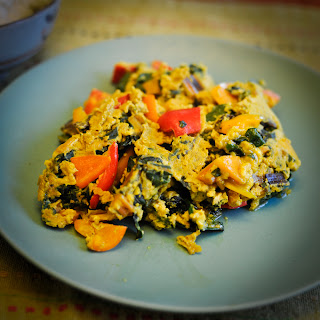This meatless meatball is made of a mixture of mushrooms and walnuts with seasonings. I think this mixture is one of the most delicious vegetarian alternatives to ground beef. I am always amazed by how meaty it tastes. According to
raw foodists on YouTube, you can dehydrate the meatballs in a dehydrator or in an oven at 115
°F for several hours (to preserve the nutrients and enzymes in raw food), but I usually pan-fry them with 1 TBSP of oil to save time and electricity. This "moyashi" (mung bean sprouts) and "beni shoga" (pickled red ginger) salad is a tasty and nutritious side dish that is super-easy to make. I found
the original recipe at the largest Japanese recipe site called "Cookpad" when looking for ways to eat home-grown mung bean sprouts.You can find pickled red ginger and Japanese mayonnaise at most East Asian grocery stores. I know that mayonnaise is not the healthiest thing, but I cannot resist using a small amount of Japanese mayonnaise occasionally because it does some magic for many dishes.
Meatless meatballs (for 4 servings)
Ingredients:
1 pack of mushrooms (portabella or white)
2 cups of walnuts
1 tsp of soy sauce, 1 tsp of olive oil, and 1 clove of garlic (for marinating mushrooms)
1 tsp of thyme
1 tsp of oregano
1 TBSP of fresh parsley (or 1 tsp of dry parsley)
2 cloves of garlic
1/2 tsp of natural salt
2 small pieces of "taka no tsume" (or any other kinds of red hot chili peppers)
1-2 TBSP of olive oil (for consistency)
1 TBSP of canola oil (or any other kinds of oil of your choice for pan-frying)
Need a food processor and your favorite meatball sauce (e.g., sweet and sour sauce, BBQ sauce, soy sauce with "mirin" [rice wine sweetener], and tomato sauce).
Directions:
1. Soak walnuts in water for 1 hour or longer.
2. Marinate mushrooms in soy sauce, grated garlic, and olive oil for 1 hour or longer.
3. Put #1 and #2 in a food processor. Add all the seasonings and 1 TBSP of olive oil in. Run the food processor until the mixture turns into the right consistency for meatballs. Add another TBSP of olive oil if necessary.
4. Take 1 tsp of the mixture and make a small piece of meatball. (The mixture is softer and looser than regular meatballs, so a large piece tends to crumble. )
5. Pan-fry the meatballs with 1 TBSP of oil of your choice until they are brown.
6. Pour a sauce of your choice over the meatballs.
Mung bean sprouts and pickled red ginger salad (for 4 servings)
Mung bean sprouts (4 TBSP of mung beans sprouted to almost fill a quart jar. See the directions
here.)
1 TBSP of "beni shoga" (pickled red ginger)
1 TBSP of Japanese mayonnaise
Need a large bowl.
Directions:
1. Put the sprouts in boiling water for 30 seconds and drain.
2. In a large bowl, mix the blanched sprouts with pickled red ginger and Japanese mayonnaise.











